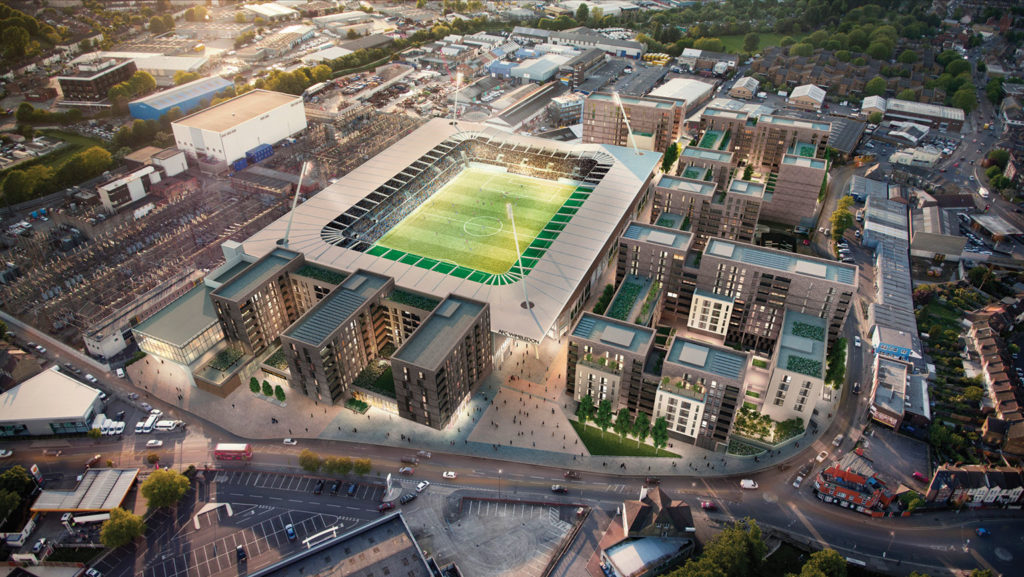Wimbledon’s historic greyhound stadium may be approaching the finishing line as plans to develop the site for housing and a football stadium pick up speed again. Louisa Clarence-Smith reports
Key points
- Redevelopment plans to call time on London’s last greyhound stadium
- Proposals held up by politics and nimbyism
- Development could provide a valuable economic boost
It’s a rainy Saturday night in September at Wimbledon Greyhound Stadium, SW17, and the bar and restaurant are packed. Bookmaker John Henwood is bent over his trackside box counting his takings. He has been working Thursday and Saturday nights at the stadium for 34 years. But he fears his time at London’s last dog track could soon be up.
The stadium’s owner, Galliard Homes, submitted plans in 2014 to redevelop the track into a 602-unit housing development and 20,000-seat football stadium for AFC Wimbledon.
The plans have since been at the centre of a vicious planning battle between football fans, greyhound lovers, two local authorities and two London mayors.

Now it is crunch time. In September, Sadiq Khan decided to hand back the planning decision [originally called in by former mayor Boris Johnson] to Merton Council, which approved the scheme for the second time.
The developer cleared one final hurdle at the end of last month when secretary of state Sajid Javid dismissed a last-ditch appeal by Conservative-led Wandsworth Council to reconsider the scheme on the grounds that Labour-led Merton Council’s approval required an “additional degree of scrutiny and assessment by an impartial authority”.
Greyhound enthusiasts have decried what would be the loss of the last existing track with a London postcode. If Wimbledon is redeveloped, the closest stadium to enjoy the sport will be in Romford, Havering.
“I think it is a noble, well-controlled sport,” Henwood says. “The dogs love it, otherwise they wouldn’t come out of the hatch. They are extremely fast and it is a spectacle. And it is something different for London. Every night someone comes to me with euros. Foreign people love it.”
He said the greyhound fans were not against the housing development, but the loss of a cultural asset that can benefit “thousands of people” for the sake of a football stadium, which will “line the pockets of a few”.
Is a greyhound stadium a viable leisure proposition in London today? Despite the packed bar and spectators of all ages, outside hundreds of seats lie empty. The racing, which has been held at Plough Lane since 1928, is undoubtedly in decline and has faced some controversy over the treatment of the dogs.
A 26-year-old insurance broker at Lloyds on his second visit to the stadium says: “It’s sad but I suppose the land values in London just don’t make them financially viable any more.”
Stephen Alambritis, leader of Merton Council, says the local authority would have considered plans for an alternative mixed-use development with a greyhound track. The council had earmarked the site in its 2012 Local Plan for sporting intensification, without specifying a sporting preference. However, no greyhound plans were ever submitted.
Enter Pascal Taggart, an Irish businessman who wanted to buy the stadium for a proposed mixed-use redevelopment – including a greyhound stadium.
He says he visited Merton Council in 2012 to discuss the proposals, so why didn’t he submit any plans? “It would cost me £1m-£1.5m to submit the plans,” he says – a big upfront cost, without any certainty of getting the go-ahead, curbed his ambition.
He believes he could have created a market for greyhound racing. “We created a market in Ireland, which has a very small population,” he says. “We had no doubt that we could do it – and it would have been very successful.”
Taggart isn’t planning to build another stadium elsewhere in the capital. “The cost of land in London is so outrageously high that you cannot build another one,” he says. “But Wimbledon was a classic one and it was where the Derby was held, etc. And once it has gone, it is almost the end of greyhounds as we know it.”
The Plough Lane saga shows how developers can fall victim to the political agendas of mayors, local authorities and even ministers.
Boris Johnson used his mayoral powers to call in the planning decision in March 2016, after expressing concerns over issues including the level of affordable housing, flood risks and transport congestion. He later hinted that the decision had been a mistake, before leaving office in May without having made a decision on the plan.
In an apparent challenge to Johnson, Sadiq Khan, who had previously opposed the scheme as MP for Tooting, which borders the development, passed the decision back to Merton Council, despite the fact its 9.6% affordable housing provision falls far short of his own 50% target. The mayor’s office did not respond to requests for comment.
Duncan Parr, head of planning at Savills’ Sevenoaks office, is advising Galliard Homes and AFC Wimbledon on the plans. He says, “We have been running over local elections, mayoral elections, parliamentary elections and in varying ways at each occasion people have latched on to this whole cause to suit their needs and suit the populist view that will help them be elected.”
Hundreds of local residents have objected to the development on the grounds of increased road congestion and expected disruptive behaviour from football fans. However, it has also been subject to strict viability appraisals and multiple approved reviews.
“The council has assessed the viability very, very rigorously,” Parr says. “It has had an independent consultant look at it. It has also sent that further out to another body, CBRE, to do an independent red book valuation, and it has even had that red book valuation assessed by another agent.”
He adds: “It has gone through the mayor, the Environment Agency, Historic England, TfL – so many bodies have looked at this and said it is acceptable… It does show the nimbyism that affects our planning system.”
Despite the additional costs to Galliard caused by the delays, Parr says the housebuilder and football club remain committed to the scheme. However, he says a decision by the secretary of state to order an appeal would have put it in doubt.
It would certainly be a historic return for AFC Wimbledon, at present based at the Kingsmeadow stadium in Kingston. The club, which stepped into the breach when Wimbledon FC controversially relocated to Milton Keynes in 2003, is at an all-time high, having for the first time overtaken their bitter rivals, the rebranded MK Dons, in the League One table. With the power of footballers, money and inward investment behind the proposals, this could be the last days of the dogs. As declared by AFC Wimbledon chief executive Erik Samuelson: “After so many years in exile, the Dons are coming home.”
Football’s coming home
AFC Wimbledon and Galliard Homes plans
20,000
seat football stadium, starting at 11,000 seats and being built in stages
602
homes on the Wandsworth-Merton boundary in Plough Lane
13,700 sq ft
retail unit
18,620 sq ft
squash and fitness club
Architect Sheppard Robson
London’s redeveloped greyhound stadiums
White City Stadium, W12
Closed in 1984 and acquired by the BBC for the development of its White City building. The site was originally built for the 1908 Olympic Games, but was taken over by the Greyhound Racing Association in 1927. The building forms part of the Media Village site, which was bought last year by Stanhope and Mitsui Fudosan for £87m.
Catford Stadium, SE6
Closed in 2003. Barratt Homes gained planning consent in 2009 for a redevelopment comprising 589 homes.
Walthamstow stadium, E4
Closed in 2008. L&Q housing association acquired the site for a 294-home redevelopment. Approved in 2012, the plans also included a nursery, café, sports centre and pocket allotments.
• To send feedback, e-mail Louisa.Clarence-Smith@estatesgazette.com or tweet @LouisaClarence or @estatesgazette











